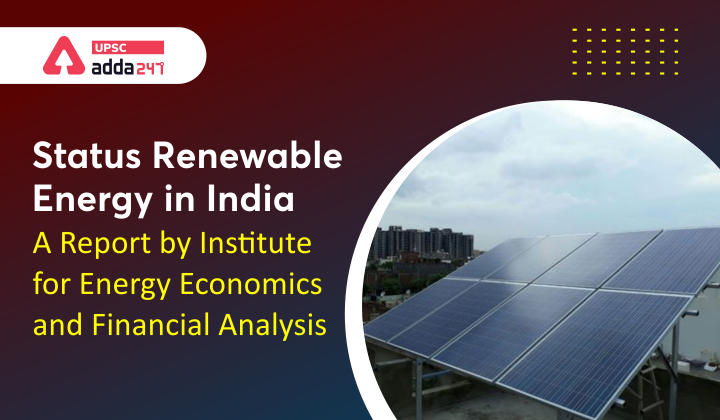Table of Contents
Status Renewable Energy in India- Relevance for UPSC Exam
- GS Paper 3:
- Infrastructure- Energy;
- Environment- Conservation, environmental pollution and degradation.
Status Renewable Energy in India- Context
- According to a report by the Institute for Energy Economics and Financial Analysis (IEEFA), the lockdowns slowed renewable energy installations in the country and the pace of such installation is lagging India’s 2022 target.
- IEEFA is a USA-based non-profit corporation.
A scheme before its time- National Digital Health Mission
India’s Renewable energy targets and performance
- In order to reduce greenhouse gas emissions, India aims to install 175 gigawatts (GW) of green energy by 2022 and 450GW by 2030.
- Only 7 GW of such capacity was added in FY 2020/21.
- Central Electricity Authority’s data shows that India was to have installed 100 GW of solar energy capacity by March 2023 (40 GW rooftop solar and 60 GW ground-mounted utility-scale).
- India has managed to install only 43.94 GW till July 31, 2021.
United Nations General Assembly (UNGA)- About, Composition and Key Functions
Status Renewable Energy in India- Key Findings
- Increase in overall power traded and price on the Indian Energy Exchange (IEX): the amount of power traded increased by 20% over 2020, by 37% compared to 2019 and by 30% over 2018.
- This led to prices on average increasing by 38% compared to 2020, by 8% compared to 2019 and by 11% over 2018.
- The report says that if there had been more access to renewable energy, particularly wind and hydropower, it could have contributed to lower energy prices.
- Coal stocks: it hit a new record high of 1,320 lakh tonnes (Mt) at the end of FY2020/21 and exceeded the monthly averages of the previous five years.
- Focus on domestic coal led to reliance on imported coal. India’s largest coal producer had about two months’ supply.
- More thermal power plants reporting critical coal supplies: Most plants had coal stockpiles for 1 to 5 days. However, the requirement for thermal power plants is to maintain coal supplies for 21 days or at least 15.
- In most cases, the issue of supply was at the thermal power producer end, rather than the issue of coal stock shortage at the CIL end.
Cyclone Gulab- Key Features and Naming of Cyclones
Associated Suggestions of the Report
- ‘Flexible and dynamic generation solutions’ is the need of the Indian electricity system to meet the challenge of India’s growing daily peak demand.
- It does not require investment in excess baseload thermal capacity.
- ‘Flexible and dynamic generation solutions’: such as battery storage, pumped hydro storage, peaking gas-fired capacity and flexible operation of its existing coal fleet.
- Government should accelerate the deployment of such sources to help meet peak demand and also balance the grid at a lower cost.
- Their prices were falling and so would be cost-effective and a buffer against very high prices at the power exchange during peak demand.




 TSPSC Group 1 Question Paper 2024, Downl...
TSPSC Group 1 Question Paper 2024, Downl...
 TSPSC Group 1 Answer key 2024 Out, Downl...
TSPSC Group 1 Answer key 2024 Out, Downl...
 UPSC Prelims 2024 Question Paper, Downlo...
UPSC Prelims 2024 Question Paper, Downlo...




